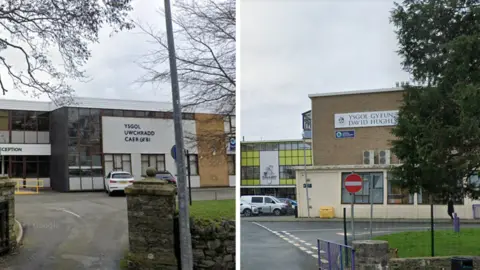Raac: No more found in Wales' schools as search continues
 Google
GoogleNo more schools have been found in Wales with the weak concrete that led to two closing to pupils.
The Welsh government has published an update with the latest information as investigations continue in some areas.
Some pupils at Anglesey's Ysgol David Hughes, in Menai Bridge, have returned while Ysgol Uwchradd Caergybi is due to partially reopen on Monday.
Education minister Jeremy Miles said a complete picture would be available by 15 September at the latest.
In England a list of 147 schools shut by Raac has been published by the UK government.
Mr Miles accepted Raac (reinforced autoclaved aerated concrete) could still be found in other schools, but felt reassurance could now be taken.
He said the Welsh government's action on Anglesey was "was precautionary and very responsible".
"When new information comes to hand it's very important, when it could have a bearing on safety, for us all to act cautiously and this is what has been done," he said.

"With the new information that has come to light since then, we know that the guidance that the expert engineers issue and everyone operates to, is not going to be changed.
"But it's a question of applying that in light of the new information, and that is what is happening in Ynys Mon."
Anglesey council, he said, knew Raac was in the two secondary schools since 2020 and had undertaken annual surveys.
The Welsh government said there would also be a new survey to identify Raac in other public buildings - such as theatres, leisure facilities and offices.
That will also be published on 15 September.
On Friday it was announced Raac was found in the swimming pool at Caernarfon leisure centre, which has been closed until further notice.
In August patients were moved from Pembrokeshire's Withybush Hospital after it was found.
On Thursday Cardiff's St David's Hall was forced to close after it was found there.
The Health and Safety Executive has warned Raac is liable to "collapse with little or no notice".
The lightweight form of precast concrete was used in many public sector buildings in the UK from the mid-1960s to the mid-1980s.
UK government guidance for schools in England issued in August said there have been "sudden collapses of Raac panels in roofs that appeared to be in good condition".

But on Thursday Wales' First Minister, Mark Drakeford, said Raac was not a danger in itself and could be properly managed and maintained.
He also said that during the week "not a single other school" had been identified.
After the UK government announced the closures of schools in England, the Welsh government began speaking to councils to review the information it had.
BBC Wales has been told councils had been given until Wednesday next week to get back to the Welsh government.
What is Raac?
Construction expert Keith Jones said Raac is a light "bubbly" concrete, which meant it was used in roofs, but that it doesn't have the "inherent strength of reinforced concrete and has a limited shelf life".
"I think the important thing to remember is that it is different, it is identifiable, it's got this bubbly texture," Mr Jones said.
The Health and Safety Executive said Raac was "now life-expired", and was "liable to collapse with little or no notice".
